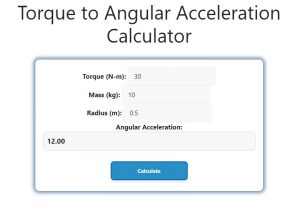About Torque to Angular Acceleration Calculator (Formula)
In the field of physics and engineering, understanding the relationship between torque and angular acceleration is vital for analyzing rotational motion. The Torque to Angular Acceleration Calculator simplifies this process by providing a straightforward method to compute angular acceleration based on applied torque, mass, and the radius of the rotating object. This tool is essential for engineers, physicists, and anyone involved in the design or analysis of mechanical systems that involve rotational movement.
Formula
The formula for calculating angular acceleration is:
Angular Acceleration (AA) = (Torque / Mass) / (Radius^2)
Where:
- AA = Angular Acceleration (in radians per second squared)
- Torque = Applied Torque (in Newton-meters)
- Mass = Mass of the object (in kilograms)
- Radius = Radius at which the torque is applied (in meters)
How to Use
Using the Torque to Angular Acceleration Calculator is straightforward. Follow these steps:
- Gather Required Inputs:
- Measure the applied torque in Newton-meters.
- Determine the mass of the object in kilograms.
- Measure the radius in meters at which the torque is applied.
- Input Values into the Formula:
- Substitute the gathered values into the formula to compute the angular acceleration.
- Calculate Angular Acceleration:
- Perform the calculation to find the angular acceleration of the object.
- Interpret Results:
- Analyze the angular acceleration to understand the rotational motion of the object.
Example
Let’s consider an example to illustrate the calculation. Assume the following parameters:
- Torque = 30 Newton-meters
- Mass = 10 kilograms
- Radius = 0.5 meters
Substituting these values into the formula:
AA = (30 / 10) / (0.5^2)
Calculating this step-by-step:
- AA = (30 / 10) / (0.25)
- AA = 3 / 0.25
- AA = 12 radians per second squared
In this example, the angular acceleration of the object would be 12 radians per second squared.

FAQs
- What is torque?
- Torque is a measure of the rotational force applied to an object, causing it to rotate around an axis.
- What is angular acceleration?
- Angular acceleration is the rate of change of angular velocity of an object over time, measured in radians per second squared.
- How is torque related to angular acceleration?
- Torque causes angular acceleration; the greater the torque applied, the greater the angular acceleration produced, given a specific mass and radius.
- What units are used for measuring torque?
- Torque is typically measured in Newton-meters (N·m).
- What factors influence angular acceleration?
- Angular acceleration is influenced by the amount of torque applied, the mass of the object, and the radius at which the torque is applied.
- Can angular acceleration be negative?
- Yes, negative angular acceleration indicates that the object is slowing down in its rotation.
- What is the significance of the radius in this calculation?
- The radius determines how far the torque is applied from the center of rotation, affecting the resulting angular acceleration.
- How do I measure the torque applied to an object?
- Torque can be measured using a torque wrench or calculated based on force applied at a specific distance from the pivot point.
- What happens if the mass increases while keeping torque constant?
- If the mass increases while the torque remains constant, the angular acceleration will decrease due to the larger mass resisting acceleration.
- Is this calculator applicable for all rotating objects?
- Yes, this calculator can be applied to any rotating object where torque, mass, and radius are known.
- How does angular acceleration affect the motion of an object?
- Angular acceleration determines how quickly an object speeds up or slows down its rotation, impacting overall motion dynamics.
- Can I use this formula for objects with varying mass?
- The formula assumes a constant mass; for varying mass, more complex dynamics must be considered.
- What are some practical applications of this calculation?
- This calculation is used in engineering applications, robotics, vehicle dynamics, and machinery design.
- How can I increase angular acceleration?
- You can increase angular acceleration by applying more torque, reducing mass, or increasing the radius.
- Are there any safety considerations when working with rotating objects?
- Yes, safety precautions should always be taken to prevent injuries from moving parts and to ensure equipment is properly maintained.
- What tools are used to measure angular acceleration?
- Angular acceleration can be measured using sensors such as gyroscopes or accelerometers.
- Can angular acceleration be calculated from angular velocity?
- Yes, angular acceleration can be calculated as the change in angular velocity over time.
- What is the relationship between linear acceleration and angular acceleration?
- Linear acceleration is related to angular acceleration by the radius; linear acceleration = angular acceleration * radius.
- What role does friction play in torque and angular acceleration?
- Friction can affect the amount of torque needed to achieve a certain angular acceleration, often requiring more torque to overcome frictional forces.
- Where can I find more information on rotational dynamics?
- Resources like physics textbooks, engineering handbooks, and online educational platforms provide comprehensive information on rotational dynamics.
Conclusion
The Torque to Angular Acceleration Calculator is a valuable tool for anyone involved in analyzing rotational systems. By understanding the relationship between torque, mass, and radius, individuals can accurately determine angular acceleration and optimize their mechanical designs. Whether in engineering, physics, or practical applications, mastering this calculation enhances comprehension of rotational dynamics and contributes to improved system performance.